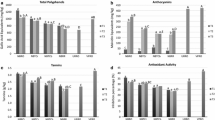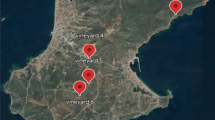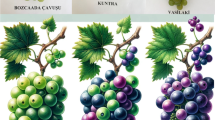Abstract
The criteria for estimating optimal maturity in red grapes are complex. The ratio sugars/acids do not give enough information to determine precisely the date of harvesting. The accumulation of phenolic compounds depends on climate, soil, genetics and cultural practices. Grape phenolics , which are structurally diverse, therefore have a variable extraction potential (called extractability). This chapter discusses the methods for determining phenolic maturity based on anthocyanin extraction from the whole berries. First, the description and modifications done by different authors are explained. Second, the interpretation of values and indexes is exposed. Finally, the effects of environmental and genetic factors on phenolic content of grapes and the colour extractability are commented.
Access this chapter
Tax calculation will be finalised at checkout
Purchases are for personal use only
Similar content being viewed by others
Abbreviations
- AOC:
-
Wine county region, (Appellation d’Origine Controlée)
- DAD:
-
Diode Array Detection
- DMACH:
-
p-dimethylaminocinnamaldehyde
- HPLC:
-
High Performance Liquid Chromatography
- HPLC-MS:
-
Liquid Chromathography coupled to Mass Spectrometry
- IPT:
-
Absorbance at 280 nm, Total Phenol Index
- NIR:
-
Near Infrared
- MS:
-
Mass Spectrometry
- PAL:
-
Phenylalanine Ammonia Lyase
- PAR:
-
Photosynthetic Active Radiation
- UV-Vis:
-
Ultraviolet Visible
References
Bisson L (2001) In search of optimal grape maturity, Dept of Enology and Viticulture, UC Davis, July/Ag, 32–43
Boulton R, Singleton V, Bisson L, Kunkee R (1996) Principles and practices in wine making. The Chapman and Hall Enology Library
Cacho J, Fernández P, Ferreira V, Castells JE (1992) Evolution of five Anthocyanidin-3-glucosides in the skin of the Tempranillo, Moristel, and Garnacha grape varieties and influence of climatological variables. Am J Enol Vitic 43:244–248
Cagnasso E, Rolle L, Caudana A, Gervi V. (2008) Relationship between grape phenolic maturity and red wine phenolic composition. Ital J Food Sci 20:365–380
Calò A, Tomasi D, Crespan M, Costacurta A. (1996) Relationship between environmental factors and the dynamics of growth and composition of the grapevine. Proc. workshop strategies to optimize wine grape quality. Acta Hort 427:217–231
Celotti E, and Carcereri G. (2000) La qualità fenolica delle uve rosse: valutazzione oggettiva mediante misura del colore. Ind Bev 29:168–138
Celotti E, Vedova T. della, Ferrarini R, Martinand S. (2007) The use of reflectance for monitoring phenolic maturity curves in red grapes. Ital J Food Sci 19:91–100
Choné X, Van Leeuwen C, Chéry P, and Ribereau-Gayon P. (2001) Terroir influence on water status and nitrogen status of non-irrigated Cabernet sauvignon (Vitis vinifera): Vegetative development, must and wine composition (example of Medoc top Estate vineyard, Saint Julien Area, Bordeaux, 1997. S Afr J Enol Vitic 22:8–15
Dambergs RG, Cozzolino D, Esler MB, Cynkar WU, Kambouris A, Francis IL, Hoi PB, Ginshen M. (2003) The use of infrared spectroscopy for grape quality measurement. Aust NZ Grapegrowers Winemaker 473:76–69
De Freitas VP, Glories Y, Bourgeois G, Vitry C. (1998) Characterization of oligomeric and polymeric procyanidins from grape seeds by liquid secondary ion mass spectometry. Phytochemistry 49:1435–1441
Di Stefano R, Cravero MG, Gentilini N (1991) Metodi per lo studio dei polifenoli dell’uva, Riv Vitic Enol 44:37
Di Stefano R, Borsa D, Bosso A. (2000) Documento tecnico sul significato e sui metodi di determinazione dello stato di maturità dei polifenoli. L’enologo 12:73–76
Downey MO, Dokoozlian NK, Krstic MP (2006) Cultural practices and environmental impacts on the flavonoid composition of grapes and wine: a review of recent research. Am J Enol Vitic 57:257–268
Edo M, Lampreave M, Nadal M (2009) Effects of mesoclimate and vintage on grape composition in a warm summer region, GESCO 12–16 July, Davis CA, 2009
Glories Y (1984) La couleur des vins rouges II. Mesure, origine et interpretation. Conn Vigne Vin 18:253–271
Glories Y, Augustin M (1993) Maturité phénolique du raisin, consequences technologiques: application aux millesimes 1991 et 1992. Actes du colloque: Journée technique du CIVB. Bordeaux, 21 janvier, 56–61
González-San Jose ML, Santa-Maria G, Diez C (1990) Anthocyanins as parameters for differentiating wines by grape variety, wine-growing region, and wine-making methods. J Food Composit Anal 3:54–66
González-San José ML, Barrón LJ, Junquera B, Robredo LM (1991) Application of principal component analysis to ripening indices for wine grapes. J. Food Composit Anal 4:245–255
Harbertson F, Adams JA (2002) Tannins in skins and seeds of Cabernet sauvignon, Syrah and Pinot noir berries during ripening. Am J Enol Vitic 53:54–59
Hunter JJ, Ruffner HP, Volsench C (1995) The effect of partial defoliation on growth characteristics of Vitis vinifera cv Cabernet Sauvignon II. Reproductive growth in grapevine. S Afr J Enol Vitic 121:869–874
Hunter JJ, Pisciotta, A, Volschenk, CG, Archer E, Novello V, Kraeva E, Deloire A, Nadal M. (2004) Role of harvesting time/optimal ripeness in zone/terroir expression. Proc. Joint OIV, GESCO, SASEV Intl Conference on Viticultural Zoning, 15–19 November 2004, Cape Town, South Africa, 466–478
Iland PG, Cynar W, Francis LI, Williams PJ, Coombe BG (1996) Optimisation of methods for determination of total and red free glycosyl- glucose in black grape berries of Vitis vinifera. Aust J Grape Wine R 2:171–178
Iland PG, Ewart A, Sitters J, Markides A, Bruer N (2000) Techniques for chemical analysis and quality monitoring during winemaking, Patrick Iland Wine Promotions, Campbelltown, SA
Jackson JI, Lombard PB (1993) Environmental and management practices affecting grape composition and wine quality – A review. Am J Enol Vitic 44:409–429
Jensen JS, Blachez B, Egebo M, Meyer AS (2007) Rapid extraction of polyphenols from red grapes. Am J Enol Vitic 58:451–461
Jensen JS, Damiray S, Egebo M, Meyer AS (2008) Prediction of wine colour attributes from the phenolic profiles of red grapes (Vitis vinifera). J Agric Food Chem 56:1105–1115
Jordao A. M, Ricardo da Silva JM, and Laureano O. Evolution of anthocyanins during grape maturation of two varieties (Vitis vinifera L.). (1998) Castelao Frances and Touriga Francesa. Vitis 37:93–94
Kennedy JA, Hayasaka Y, Vidal S, Waters EJ, Jones GP (2001) Composition of grape skin tannins at different stages of berry development. J Agric Food Chem 49:5348–5355
Kennedy JA, Matthews MA, Waterhouse AL (2000) Changes in grape seeds polyphenols during fruit ripening. Phytochemistry 55:77–85.
Kramling TE, Singleton VL (1969) An estimate of the nonflavonoid phenols in wines. Am J Enol Vitic 20:86–92
La Notte E, Liuzzi VA, Esti M. (1992) The polyphenolic wine components 2. Note: Anthocyanins content and composition in relation to different winemaking techniques. Vignevini 19:49–55
Lamadon F (1995) Protocole pour l’évaluation de la richesse phénolique des raisins. Revue des Enologues 76:37–38
Mateos S (2003) Determinació de la maduresa fenòlica en varietats de raïm negres, DEA, Universitat Rovira i Virgili
Mateos S, Valls J, Nadal M, Arola L (2001) Estudio de la madurez fenólica sobre diferentes variedades tintas y su relación con el color de los vinos. Tecnología del vino 2:45–50
Mattivi F, Prast A, Nicolini G, Valentine L (2003) Ilpotenziale polyfenolico delle uve rosse e la sua aplicazione in enologia 39:105
Nadal, M. (2002) Els vins del Priorat. Ed. Cossetània, Tarragona, Spain
Nadal M, Lampreave M (2007) Fundamentos, aplicación y consecuencias del riego en la vid. Capítulo 5.2. – Influencia del riego en la maduración polifenólica de las bayas. In: Montsant DO (ed) Experiencia del riego en la comarca del Priorat, Agrícola Española, 231–256
Nadal M, Volschenk N, Hunter JJ (2004) Phenolic extraction during fermentation as affected by ripeness level of Syrah/R99 grapes. Proc. Joint OIV, GESCO, SASEV Intl Conference on Viticultural Zoning, 15–19 November 2004, Cape Town, South Africa
Nadal M, Hunter JJ (2007) Different wine styles as related to ripeness level of Syrah/R99 grapes, Intervitis-Interfructa, 59th German Viticulture Congress, 22–26 April 2007, Stuttgart, Germany
Nadal M, Mateos S, Lampreave M. (2008) Influence de la topographie et du mésoclimat sur la composition des raisins et rendement dans le terroir de l’AOC Priorat, VII Congres Int. terroirs viticoles 19–23 mai 2008 Nyon, Suïssa, 2:590–595
Nagel CW, Glories Y (1991) Use of a modified Dimethylaminocinnamaldehyde reagent for analysis of flavanols. Am J Enol Vitic 42:364–366
Ojeda H, Andary C, Kraeva E, Carbonneau A, Deloire A (2002) Influence of pre- and post-veraison on water deficit, synthesis and concentration of skin phenolic compounds during berry growth of Vitis vinifera cv. Shiraz. Am J Enol Vitic 53:261–267
Peyron D. (1998) Le potentiel phénolique du pinot noir. Rev Fr œnol 170 :42–45
Ribéreau-Gayon P (1970) Le dosage des composes phénoliques totaux dans les vins rouges. Chemist-Analyst 52:627–631
Ribéreau-Gayon P, Stonestreet E (1965) Le dosage des anthocyanes dans les vins rouges. Bull Soc Chim 9 :2649–2651
Ribéreau-Gayon P, Stonestreet E (1966) Dosage des tannins dans le vin rouge et détermination de leur structure. Chim Anal 48:188–196
Ribéreau-Gayon P, Glories Y, Maujean, A, Dubourdieu D. (2000) Handbook of enology, vol 2: The chemistry of wine and stabilization and treatments. Wiley, New York
Roggero JP, Archier P (1989) Mise au point d’une méthode de dosage des phénols simples des vins. Application à des vins d’origines et d’âges différents. Conn Vigne Vin 23:25–27
Roggero JP, Coen S, Ragonnet B (1986) High peformance liquid chromatography survey on changes in pigment content in ripening grapes of syrah. An approach to anthocyanin metabolism. Am J Enol Vitic 36:77–83
Roson JP, Moutounet M (1992) Quantités d’anthocyanes et de tanins des raisins de quelques cepages du sud-ouest en 1988 et 1989. Rev Fr Oenol 32:17–27
Roubelakis-Angelakis KA, Kliewer WM (1986) Effect of exogenous factors on phenylalanine ammonia lyase activity and accumulation of anthocyanins and total phenolics in grape berries. Am J Enol Vitic 53:261–267
Saint-Cricq N, Vivas N, Glories Y (1998) Maturité phénolique: définition et côntrole. Rev Fr Oenol 173:22–25
Sarneckis CJ, Dambergs P, Jones M, Mercurio M, Herderich MJ, Smith PA (2006) Quantification of condensed tannis by precipitation with methyl cellulose; development and optimised tool for grape and wine analysis, Aust J Grape Wine Res 12:39–49.
Sethuramasamyraja B, Sachidhanantham S, Yen M, Wample R (2007) Interpolation of wine grape quality indicators (anthocyanin and Brix) and development of differential harvest attachment. Am Soc Agric Bio Eng Michigan, ASAE Annual Meeting
Singleton VL, Trousdale EK. (1992) Anthocyanin-Tannin interactions explaining differences in polymeric phenols between white and red wines. Am J Enol Vitic 43:63–70
Somers TC, Evans ME. (1977) Spectral avaluation of young wines anthocyanin equilibria, toal phenolics , free and molecualr SO2, chemical age. J Sci F Agric 28:68–74
Valls J (2004) Composició fenòlica en varietats negres de Vitis vinifera. Estudi de la influencia de diferents factors. PhD. University Rovira i Virgili, Tarragona, Spain
van Leeuwen C, Friant P, Choné X, Tregoat O, Koundouras S, Dubourdieu D (2004) Influence of climate, soil, and cultivar on terroir. Am J Enol Vitic 55:207–217
Venencie C, Uveira MN, Guiet S (1997) Maturité polyphénolique du raisin mise en place d’une méthode d’analyse de routine. Rev Fr. Oenol 167:36–41
Vivas N, Glories Y, Lagune L, Saucier C, Agustin M (1994) Estimation of the polymerisation level of procyanidins from grapes and wines by use of p-dimethylaminocinnamaldehyde. J Int Sci Vigne Vin 28:319–336
Vivas de Gaulejac N, Nonier M.F, Guerra C, Vivas N (2001) Anthocyanin in grape skins during maturation of Vitis vinifera L. cv. Cabernet Sauvignon and Merlot noir from Bordeaux terroirs. J Int Sci Vigne Vin 35:149–156
Acknowledgments
The author acknowledges the partial financial support of Spanish Ministry of Science and Education through the projects AGL2005-06927-CO2-02 and AGL2008-04525-CO2-02 and to the CDTI project with UNIÓ Cooperatives Company in Tarragona, Spain. We thank the scientific collaboration of Felicidad de Herralde and Josep Valls. We thank the collaboration of Miriam Lampreave and Sumpta Mateos for laboratory work.
Author information
Authors and Affiliations
Corresponding author
Editor information
Editors and Affiliations
Rights and permissions
Copyright information
© 2010 Springer Science+Business Media B.V.
About this chapter
Cite this chapter
Nadal, M. (2010). Phenolic Maturity in Red Grapes. In: Delrot, S., Medrano, H., Or, E., Bavaresco, L., Grando, S. (eds) Methodologies and Results in Grapevine Research. Springer, Dordrecht. https://doi.org/10.1007/978-90-481-9283-0_28
Download citation
DOI: https://doi.org/10.1007/978-90-481-9283-0_28
Published:
Publisher Name: Springer, Dordrecht
Print ISBN: 978-90-481-9282-3
Online ISBN: 978-90-481-9283-0
eBook Packages: Biomedical and Life SciencesBiomedical and Life Sciences (R0)




